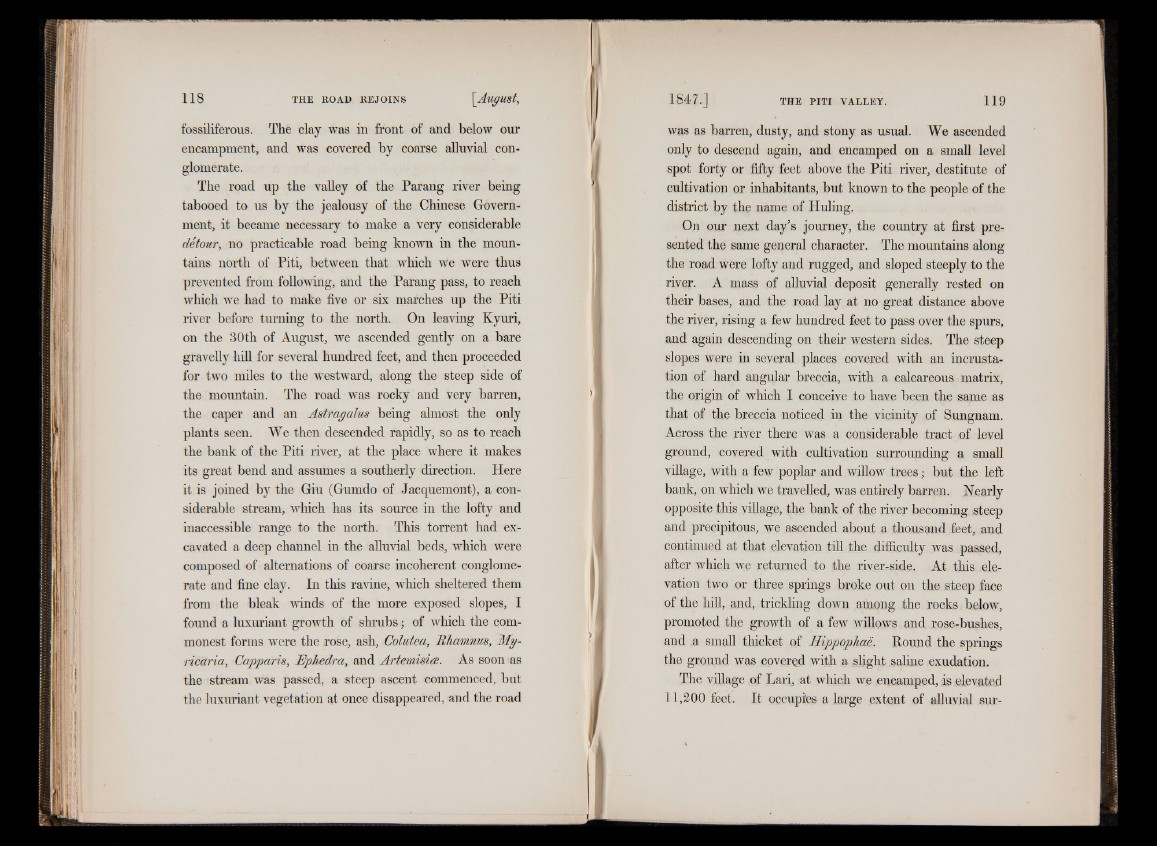
fossiliferous. The clay was in front of and below our
encampment, and was covered by coarse alluvial conglomerate.
The road up the valley of the Parang river being
tabooed to us by the jealousy of the Chinese Government,
it became necessary to make a very considerable
detour, no practicable road being known in the mountains
north of Piti, between that which we were thus
prevented from following, and the Parang pass, to reach
which we had to make five or six marches up the Piti
river before turning to the north. On leaving Kyuri,
on the 30th of August, we ascended gently on a bare
gravelly hill for several hundred feet, and then proceeded
for two miles to the westward, along the steep side of
the mountain. The road was rocky and very barren,
the caper and an Astragalus being almost the only
plants seen. We then descended rapidly, so as to reach
the bank of the Piti river, at the place where it makes
its great bend and assumes a southerly direction. Here
it is joined by the Giu (Gumdo of Jacquemont), a considerable
stream, which has its source in the lofty and
inaccessible range to the north. This torrent had excavated
a deep channel in the alluvial beds, which were
composed of alternations of coarse incoherent conglomerate
and fine clay. In this ravine, which sheltered them
from the bleak winds of the more exposed slopes, I
found a luxuriant growth of shrubs; of which the commonest
forms were the rose, ash, Colutea, Hhamnus, My-
ricaria, Capparis, Ephedra, and Artemisice. As soon as
the stream was passed, a steep ascent commenced, but
the luxuriant vegetation at once disappeared, and the road
was as barren, dusty, and stony as usual. We ascended
only to descend again, and encamped on a small level
spot forty or fifty feet above the Piti river, destitute of
cultivation or inhabitants, but known to the people of the
district by the name of Huling.
On our next day’s journey, the country at first presented
the same general character. The mountains along
the road were lofty and rugged, and sloped steeply to the
river. A mass of alluvial deposit generally rested on
their bases, and the road lay at no great distance above
the river, rising a few hundred feet to pass over the spurs,
and again descending on their western sides. The steep
slopes were in several places covered with an incrustation
of hard angular breccia, with a calcareous matrix,
the origin of which I conceive to have been the same as
that of the breccia noticed in the vicinity of Sungnam.
Across the river there was a considerable tract of level
ground, covered with cultivation surrounding a small
village, with a few poplar and willow trees; but the left
bank, on which we travelled, was entirely barren. Nearly
opposite this village, the bank of the river becoming steep
and precipitous, we ascended about a thousand feet, and
continued at that elevation till the difficulty was passed,
after which we returned to the river-side. At this elevation
two or three springs broke out on the steep face
of the hill, and, trickling down among the rocks below,
promoted the growth of a few willows and rose-bushes,
and a small thicket of Hippophae. Round the springs
the ground was covered with a slight saline exudation.
The village of Lari, at which we encamped, js elevated
11,200 feet. It occupies a large extent of alluvial sur